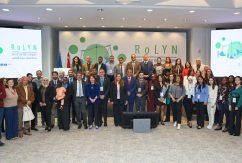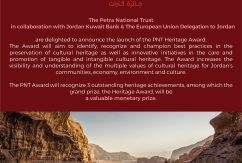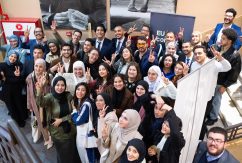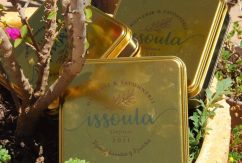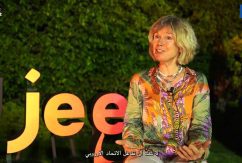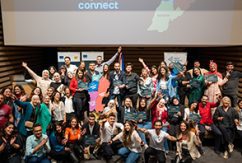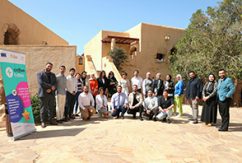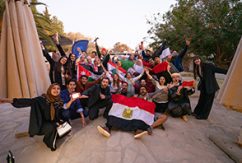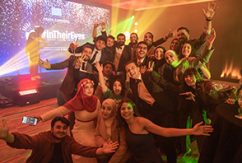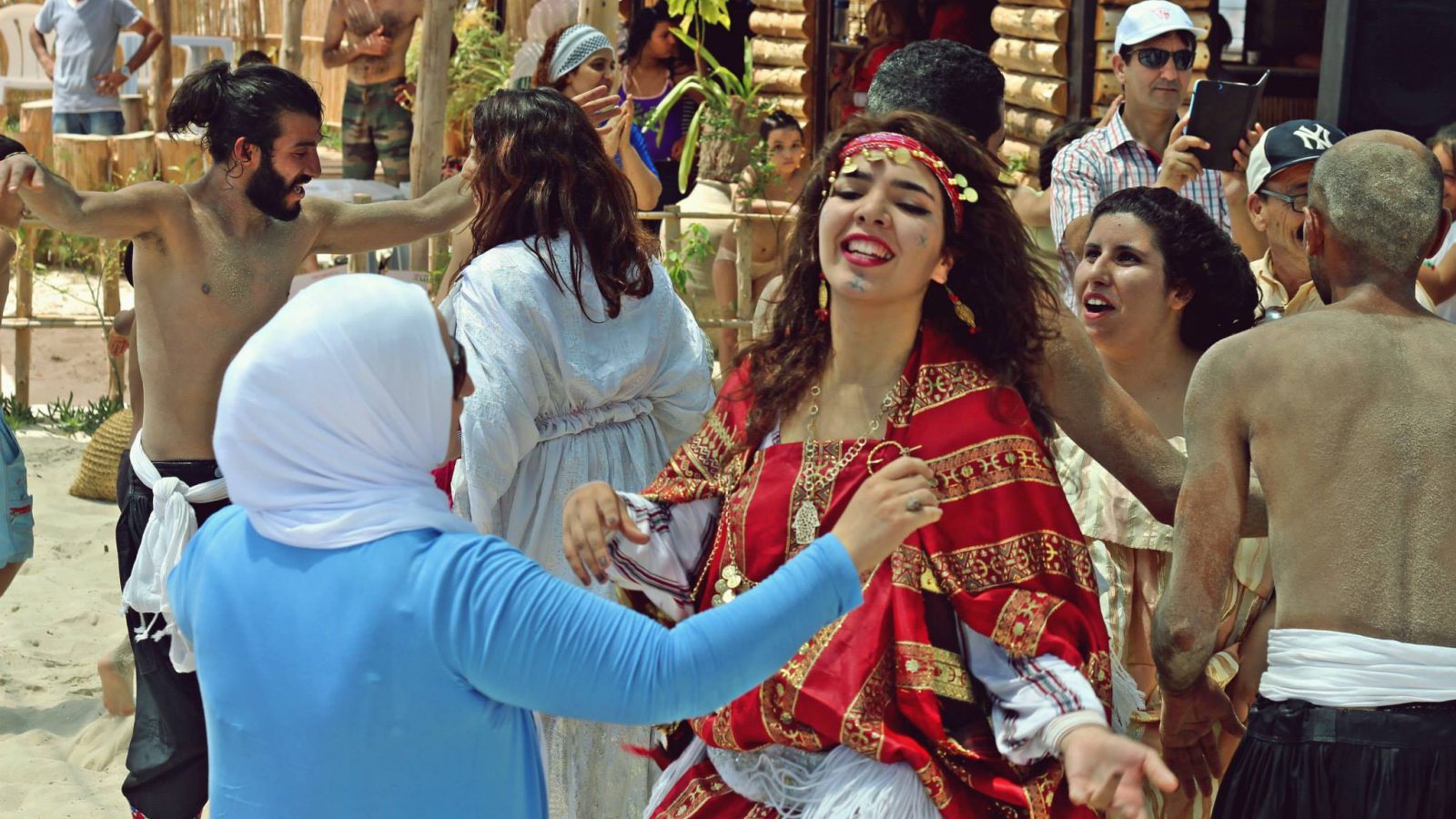Awakening the Memory of Berber Culture
The morning is bright and warm, and we follow in the footsteps of a group of tourists on their way to explore the Medina of Tunis. The Medina, with its ramparts, gates, well-trodden alleys, and squares, reveals itself to visitors as a peculiar and mysterious world in which age-old customs have been preserved from the ravages of time. The first alley on the left takes us to Souk El Blat – undeniably the most charming of all the old neighbourhoods of Tunis. Beneath its vaulted ceilings, the souk is a fragrant and lavish miniature city. Walking from one alley to the next, we come to a halt in front of Dar Bach Hamba, one of the most beautiful palaces in the Medina, where the conference and debate “Street Art and Positive Social Change in Tunis” is to take place as part of the Drama, Diversity, and Development (DDD) project financed by the European Union.
We cross the threshold of this bourgeois residence, which since 2015 has been the home of “l’Art Rue”, an association that fosters grassroots artistic projects in close relation with local populations. The entrance opens onto a sqifa that leads to a magnificent vaulted patio with a capacity of a hundred or so people. This is where Silvia Quattrini, one of the DDD project’s directors, welcomes participants and shows them to the conference room, where lectures and roundtables will take place throughout the day on the role of street art in activism and positive social change in Tunisia and the southern Mediterranean region.
Protecting Minorities
Silvia Quattrini explains that the DDD project, funded by the European Union as part of the Med Culture programme and implemented by the Minority Rights Group in partnership with the Prince Claus Fund, the Civic Forum Institute, and the Andalus Institute for Tolerance and Anti-Violence Studies, is the first project to provide subsidies for artistic events as part of the local “Media and Culture for Development in the Southern Mediterranean Region” programme. According to Quattrini, “The DDD project contributes to achieving the programme’s goals of promoting diversity and fighting discrimination against minorities through art.” This project, which is now nearing its end, has made it possible to “provide subsidies to local associations for the creation of art, based on prior research and local needs, with the goal being to fight ethnic discrimination and promote minorities’ rights,” she adds.
The results speak for themselves: thirteen artistic events have been held in Egypt, Lebanon, Gaza, and Tunisia, drawing more than 100,000 people and nearly one hundred professionals over three hundred shows.
As part of this programme, five of these events were held to benefit partner organisations such as the Association Tunisienne pour le Théâtre des Enfants et Jeunes (Tunisian Association for Children’s and Young-Adult Theatre), Danseurs Citoyens (Civic Dancers), Danseurs Citoyens Sud (Southern Civic Dancers), Art Solution, and the Fanni Raghman Anni association, which presented the Zamaken project.
Breathing New Life Into Amazigh Culture
In this spirit, Asma Kaouech, executive director of the Fanni Raghman Anni (My Art in Spite of Me) association, explains that the Zamaken project, one of the beneficiaries of DDD subsidies, was organised in three phases: research, training and production, and performances.
“The end goal of the project was to produce an artistic show (combining dance, music, and theatre) that would draw attention to the question of Amazighs in Tunisia,” she explains. “An alarming denial of minorities’ cultures and identities, based entirely on discrimination, has led us to lose sight of our Berber-speaking origins. Our desire to find a solution to this was the genesis for the Zamaken project,” says Hamdi Jouini with fervour.
Hamdi Jouini, who coordinated the research phase of the Zamaken project – also known as Amazigh fi kolli maken – explains that Tunisian Berbers, although less numerous than in other Maghreb countries, “suffer from many forms of discrimination, which pose a threat to their language and culture”.
Fighting Denial Through Art
To more effectively combat the linguistic and cultural denial faced by Tunisian Berbers, he went on a journey through the Berber villages that abound in the governorates of Gabes, Medenine, and Tataouine. “This trip allowed me to gather Amazigh stories and tales, to identify their symbols and decipher their codes, which are the foundation of our artistic performances,” he says.
According Asma Kaouech, the goal was to help society naturally make a shift toward real multiculturalism and open-mindedness, which are key elements in preventing the disappearance of the Berber identity, which need to be made “a central element in the creation of a multicultural, democratic, reconciled, and open-minded society”.
In the second phase of the project, closed courses and camps were organised. Three courses were held. They lasted ten days and brought together 20 to 30 young men and women from different regions of Tunisia with an interest in questions related to the Amazighs.
“Theatre, dance, and playwriting workshops were organised alongside lectures on minority rights, after which a selection process took place, with twelve candidates being selected,” Asma Kaouech explains.
Dorra Sayari, one of the candidates chosen, says that the teaching she received allowed her to strengthen her skill set. “Top-notch teachers with great discipline, such as Rochdi Belgacemi (a choreographer), Anis Soltani, and Anis Zgalli, in addition to Algerian teachers specialised in questions related to Amazighs, taught the courses,” she says. The result of twelve months of hard work (January 2015-January-2016) was a forty-minute show. “It is an artistic performance centred around the ancestral Berber identity. It showcases their clothing, their language – 80% of which has been assimilated into Tunisian Arabic – , and their cuisine, with its typically Berber dishes that even today are still prepared throughout the country,” says Hamdi Jouini.
Dorra, who took part in the show’s performances, smiles delightedly when asked about the audience’s reaction. “The exchanges with the audience are what encouraged us to continue our tour,” she says. This show was performed in nearly ten governorates, including those of Bizerte, Kebili, Nabeul, Kasserine, and Hammamet, as well as on Habib-Bouguiba Avenue in the very heart of Tunis. In all, ten shows were organised in Tunisia, in addition to two shows held in Rabat and Casablanca (Morocco). “After each performance, a discussion took place on the topic of Amazighs and minorities,” Asma Kaouech adds.
An Endangered Cultural Heritage
Berber communities have endured the successive military campaigns of numerous conquerors (Phoenicians, Byzantines, Romans, Arabs, etc.), each of whom succeeded to disrupting their lives and forcing them to seclude themselves in poor, isolated regions. “Now more than ever, the number of Berber speakers and the Berber language itself have shrunk to the point of becoming endangered,” Hamdi explains.
Today, a great number of mountain Berber villages, such as Toujane (Mareth Delegation), Taoujout (Old Matmata Delegation), and Zraoua (New Matmata Delegation) are deserted. This clearly shows the desolation and disintegration of Berber civilisation.
And while Berber villages have made something of a comeback, with their homes built directly on the mountainside receiving ever-more attention, “the Tunisian government [still] has to encourage Berber art in all its forms (theatre, music, dance, poetry, etc.) and to establish institutions to preserve and promote the linguistic and cultural heritage of Berbers in Tunisia,” says Hamdi Jouini, coordinator of Zamaken.
We finally bid adieu to Dar Bach Hamba after a day of listening to poignant stories about minorities. As we stroll through the souks, known for their sounds, smells, and colours, we mull over thoughts about the Amazighs and their sad fate. There is no better place than here in these hectic, magical streets – where past, present, and future collide in a lively and bustling atmosphere that attracts more tourists with each passing day – to come across the names of alleys with origins in Amazigh culture, or to breathe in the still-present odours of Amazigh cuisine.


